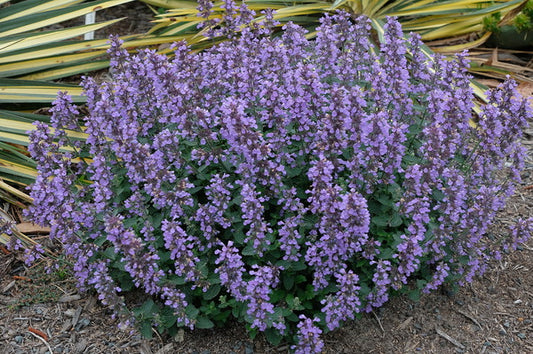Insects, deer, and bunnies do not like to eat nepeta. Nepeta (catmint) prefers a full sun site and is tolerant of humidity, heat, and dry soils. Hummingbirds are attracted to the flowers as are bees and butterflies.
-
Nepeta 'Cat's Pajamas' PP 31,127
Item #: 16656
Zones: 3a to 8b
Dormancy: Winter
Height: 14" tall
Culture: Sun
Origin: Hybrid
Pot Size: 3.5" pot (24 fl. oz/0.7 L)
Regular price $21.00Regular priceUnit price per -
Nepeta 'Purple Haze' PP 23,180
Item #: 9597
Zones: 5a to 8b, at least
Dormancy: Winter
Height: 10" tall
Culture: Sun
Origin: Hybrid
Pot Size: 3.5" pot (24 fl. oz/0.7 L)
Regular price $21.00Regular priceUnit price per
More Information About Nepeta
The genus Nepeta contains roughly 250 species of herbs native to Europe, North Africa, and temperate parts of Asia, but has been spread worldwide by gardeners. It is in the mint family (Lamiaceae) which is apparent as soon as you look at the 2-lipped flowers or smell the leaves, some of which have a minty scent.
Of course, if your cat smells nepeta (especially Nepeta cataria), its response will be different than yours. Cat noses can pick up a particular compound in the leaves called nepetalactone which creates a short-lived euphoric response. Gardeners prefer to grow nepeta cultivars such as 'Walker's Low' that have been selected for a shorter, bushier, more floriferous habit and for sterility.
Nepeta in the Garden
Insects, deer, and bunnies do not like to eat nepeta...I guess mint is not their thing. Nepeta prefers a full sun site and is tolerant of humidity, heat, dry soils, and coastal conditions. Nepeta flowers attract hummingbirds as well as bees and butterflies.
Catmint Companion Plants
Try combining with buddleia, chasmanthium, and ornamental grasses for a nice textural contrast. Just watch out for the kitty crack-heads.




